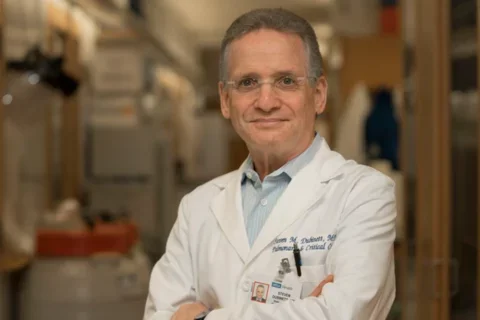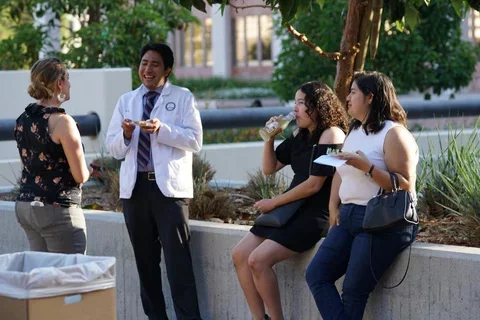Strategic Plan
Delivering on the promise of academic medicine takes a concentrated effort.
Shaping the Future
In less than a lifetime, the David Geffen School of Medicine at UCLA (DGSOM) has had a remarkable trajectory. In addition to becoming one of the most applied-to and selective medical schools in the country, our community has uncovered breakthrough discoveries that have changed the practice of medicine, including the development of the computerized tomography (CT) scan, the invention of the first tissue-typing test for transplantation, the development of multiple cancer drugs (including Herceptin, Gleevac and Xtandi), the invention of the Guglielmi coil for brain aneurysms, and the development of a new genetic therapy to cure “Bubble Baby” disease.
At the DGSOM, the promise of academic medicine is limitless:
- To create world leaders in health and science
- To discover the basis for health and cures for disease
- To optimize health through community partnerships
- To heal humankind one patient at a time
Delivering on this promise takes a concerted effort — with every member of our community working together on a set of shared priorities in service of our mission.
“ The COVID-19 pandemic and a highly effective vaccine have revealed the unprecedented potential of discovery research to save lives and buoy societies, and, at the same time, for the clinical sciences to have a similarly unparalleled potential to influence biomedical science. A unified, strategic eff ”

UCLA Health Mission Pillars
Click on a pillar to explore the vision and strategic goals associated with it.
Overarching strategic priorities
There are six main strategic priorities spanning our mission areas. Within each mission area, we have specific strategic goals that are informed and guided by our six overarching priorities.
- Ensure that academic medicine continues to thrive at UCLA amid growing funding and competitive pressures.
- Foster interdisciplinary efforts, particularly activities that advance population-wide health equity and bridge clinical medicine with academic scholarship in the basic sciences, social sciences, data sciences, and engineering.
- Transform our culture to ensure everyone in the DGSOM community feels welcome and valued.
- Increase financial transparency and the health of the school.
- Enhance our mentorship and leadership training programs in a manner that promotes EDI and provides growth opportunities for all DGSOM employees.
- Elevate the school's internal and external communications in a manner that promotes transparency, collaboration, and mission-connectedness.
Strategic Plan FAQs
The overarching UCLA Health Strategic Plan Refresh is designed to accelerate our systemwide integration and position us for continued success amid growing funding and competitive pressures. By providing an organizational roadmap for decision-making, a strategic plan allows us to establish priorities and guide processes in a concerted and sustainable manner that ensures we remain on the leading-edge of patient care, biomedical research, education and community engagement.
The current DGSOM strategic plan has its origins in an intensive school and health system-wide strategic planning process conducted in 2011 under the leadership of the former Dean, Dr. Eugene Washington. This year-long strategic planning process, which benefited from input from hundreds of DGSOM members, led to the development of the following, enduring mission statement for the DGSOM:
- To improve health and health care, the DGSOM will:
- Create world leaders in health and science
- Discover the basis for health and cures for disease
- Optimize health through community partnerships
- Heal humankind one patient at a time
In 2011, UCLA Health (DGSOM + UCLA health system) conducted a joint strategic planning process that crystalized our four mission pillars: clinical care, research, education and community engagement. The year-long data phase involved an environmental assessment, one-on-one interviews, a survey (n≈ 2,500), and an offsite leadership retreat. In 2017, UCLA Health leadership – Vice Chancellor John Mazziotta, Dean Kelsey Martin, and President/CEO Johnese Spisso – conducted a systemwide Strategic Plan Refresh to calibrate our strategic priorities in the face of a rapidly evolving health care and biomedical landscape. This led us to focus on several strategic opportunities, including the design of a more transparent funds flow and greater alignment across our clinical and academic enterprise and the University of California system.
Taken together, findings from the 2011 and 2017 strategic plans informed six overarching strategic priorities for DGSOM that underlie and inform the medical school’s mission-specific goals.
Elements of the overarching Strategic Plan Refresh that pertain to the DGSOM’s education, research and community service missions are highlighted below.
- Reassessing all policies and procedures with an equity lens
- Developing and implementing funds flow, clinical integration and Bruin Budget Model
- Enterprise Data Analytics office—drive DGSOM business/decision science
- Developing and implementing transparent data dashboards
- Creating a plan to reverse the decrease in research faculty and funding
- Ensuring stability with leadership transitions and new chairs in many departments
- Rolling out the new curriculum
- Creating robust internal, external and executive communications
One of our strategic priorities is redesigning our “funds flow,” which refers to how we allocate funds across our education, research, clinical care and public service missions. This means we’re evaluating how we approach revenue-sharing, billing, benefits, staffing payments, margin sharing and more with the goal of creating a funds flow model that sustainably supports all pillars of our shared mission. In doing so, we aim to deliver on the full potential of a top-rated medical school and health system working together to take care of patients today and create the cures of tomorrow.
A modern funds flow will also enable us to better balance the culture of a market-driven health care business with the deeply analytical culture of a university. Creating a more integrated, transparent and nimble funds flow model has been a years-long effort for UCLA Health (the DGSOM and UCLA health system) – as well as for academic medical systems nationwide – and will continue to be a top priority for our leadership team in the coming year.
As we move toward a more integrated funds flow model across our academic and medical enterprise, the role of department chairs will also need to co-evolve, pivoting to a more collective-minded leadership strategy that focuses on overall institutional success (as opposed to individual success at the departmental level).
The strategic plan serves as a guide throughout the DGSOM to inform how decisions are made and how central resource allocation is prioritized. In November 2019, Dean Martin and the DGSOM leadership team held a two-day off-site retreat to review goals, objectives and tactics for each of the four mission areas. Following on the offsite, the leadership team has been meeting quarterly to assess progress and adjust priorities and goals. In each of the four mission areas, the output of the leadership team’s work is shared with the relevant faculty constituents and committees (chairs, center directors, campus deans, FEC and academic senate) for input and shared governance via presentation and discussion at Dean’s Council meetings, Clinical Chair meetings and FEC meetings.
In addition, a new budget and goal-setting process was implemented in 2021 under the leadership of Dean Martin, Emilie Marcus, PhD, Executive Strategy Officer, DGSOM, and Megan Graves, Director, Dean’s Office Finance. The new process, which will undergo continuous quality improvement, ties each unit/department/program leader’s annual resourcing and goal-setting objectives to DGSOM's six strategic priorities, thereby providing an organization-wide compass for decision-making and resource allocations.
